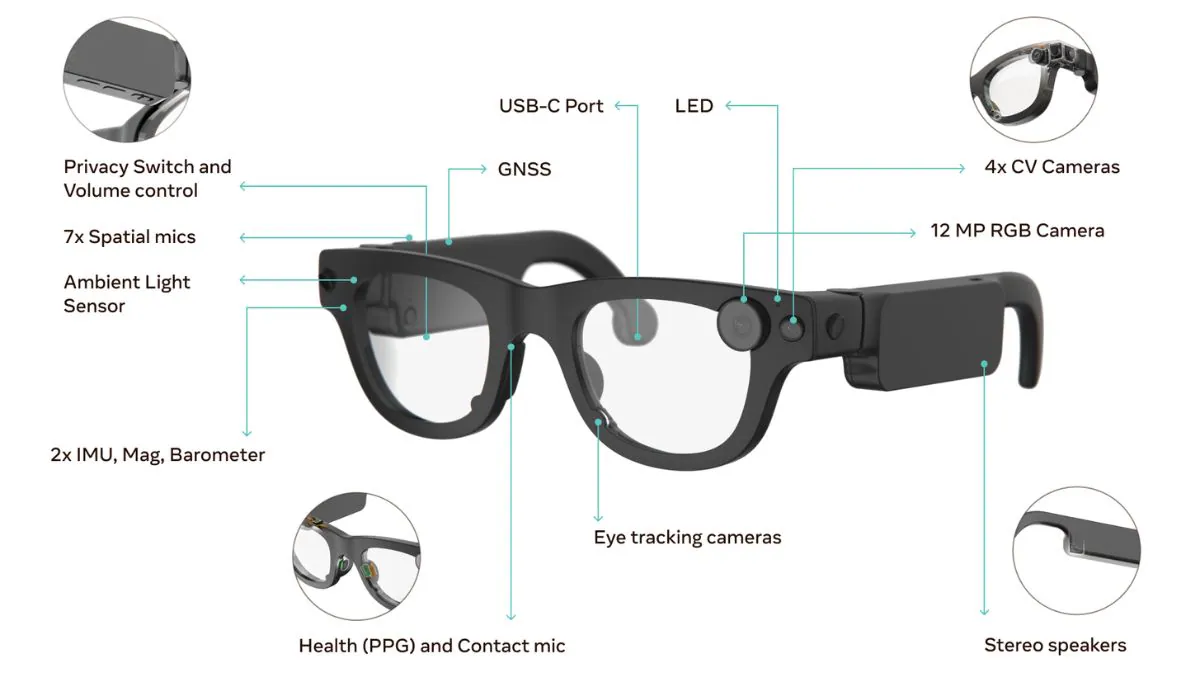Meta Aria Gen 2 Glasses Introduce Enhanced Hand and Eye Interaction

Earlier this year, Meta unveiled the Aria Gen 2, a cutting-edge wearable device designed for research purposes and the successor to the original Project Aria from 2020. This new generation of AI and machine learning-powered smart glasses features significant enhancements, including upgraded sensors and advanced tracking systems. With a focus on comfort and usability, the Aria Gen 2 aims to push the boundaries of human-computer interaction, although it is not intended for commercial release.
Enhanced Design and Comfort
The Aria Gen 2 smart glasses maintain a lightweight design, weighing between 74 and 76 grams. Meta has prioritized wearability and comfort, incorporating folding arms for easier storage and transport. The glasses are available in eight different sizes, accommodating various face shapes and sizes, including head width and nose bridge variations. This thoughtful design aims to ensure that users can wear the device for extended periods without discomfort, making it suitable for research applications.
Advanced Camera and Tracking Technology
One of the standout features of the Aria Gen 2 is its advanced camera system. The global shutter camera sensor can capture a high dynamic range of 120dB, a notable improvement from the 70dB offered by the first-generation model. This enhancement allows for better computer vision performance in diverse lighting conditions. The device is equipped with four computer vision cameras that provide a wider field of view, enabling sophisticated 3D hand and eye-tracking capabilities. The stereo overlap has also increased from 35 degrees to 80 degrees, enhancing spatial awareness and depth perception.
The eye-tracking system is particularly noteworthy, as it monitors the wearer’s gaze and provides data on gaze per eye, vergence point, blink detection, and pupil diameter. This technology has the potential to improve human-computer interaction by offering insights into the user’s visual attention. Additionally, the Aria Gen 2 can track hand movements in 3D space, allowing for precise manual labeling of datasets, which is beneficial for applications like dexterous robot hand manipulation.
Comprehensive Sensor Suite
The Aria Gen 2 is equipped with a robust suite of sensors designed to enhance its functionality. This includes a 12-megapixel RGB camera, four computer vision cameras, an ambient light sensor, and seven spatial microphones. Other hardware components include an accelerometer, GNSS, barometer, stereo speakers, a privacy switch, volume control, and a USB Type-C port.
The device also employs Visual Inertial Odometry (VIO) technology, which enables it to detect its position in six degrees of freedom (6DOF) within a spatial frame of reference. This capability is crucial for contextual AI and robotics, facilitating navigation and environmental mapping. The advanced on-device machine perception algorithms run on Meta’s custom coprocessor, ensuring efficient processing of data.
Target Audience and Future Prospects
Despite its impressive features and capabilities, the Aria Gen 2 is not intended for commercial sale. Instead, it serves as a “testbed” for the development of advanced smart glasses, aimed primarily at researchers and Meta’s partners. Notable collaborators include companies like BMW and academic institutions such as Carnegie Mellon University, IIIT Hyderabad, and the University of Bristol. This strategic focus on research and development underscores Meta’s commitment to advancing wearable technology while exploring its potential applications in various fields.
Observer Voice is the one stop site for National, International news, Sports, Editor’s Choice, Art/culture contents, Quotes and much more. We also cover historical contents. Historical contents includes World History, Indian History, and what happened today. The website also covers Entertainment across the India and World.

